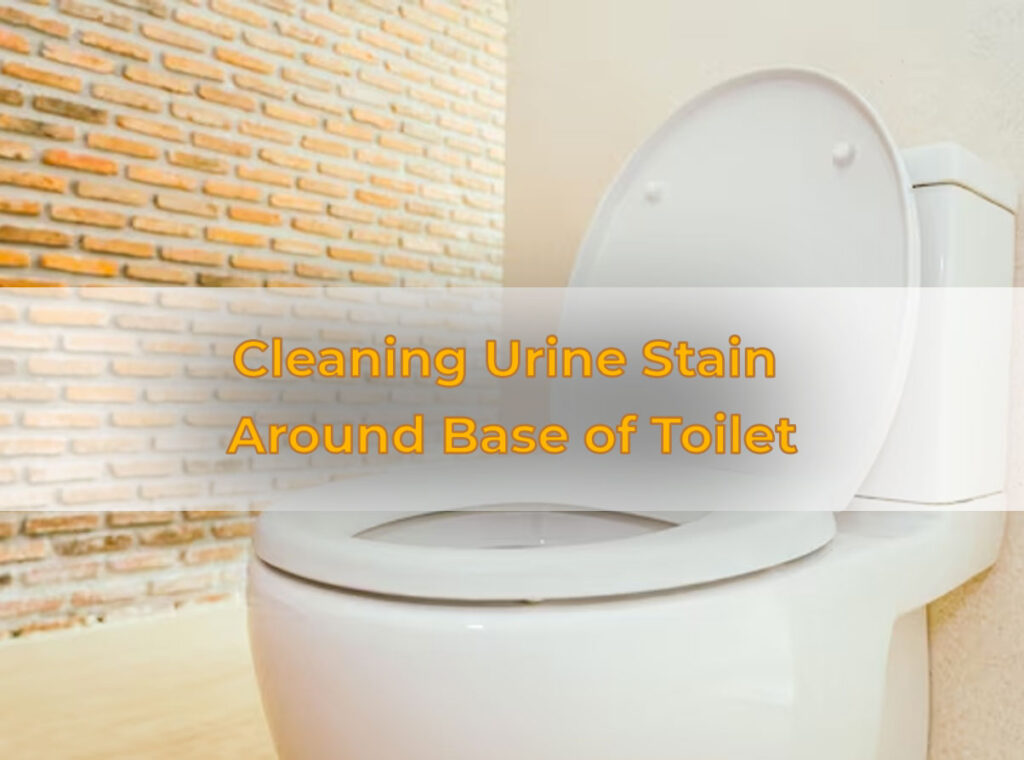Urine stain around base of toilet are a common household problem that many people face. These unsightly stains not only look unpleasant but can also create an unhygienic environment in your bathroom.
If you’re dealing with this issue, don’t worry as there are several ways to get rid of it and how to prevent future stains.
Understanding Urine Stains

Urea deposits and bacteria are to blame for those unsightly urine stains around the toilet. Getting rid of them can be difficult, and they may cause bad odors. Regular cleaning helps, but won’t always remove them. Disinfectants may help, but abrasive cleaners and brushes are needed for tougher stains. Calling a professional cleaner is the best way to avoid damaging the porcelain.
Clean your toilet at least once or twice a week with heavy-duty cleaning chemicals. Wear gloves to reduce exposure to harmful chemicals. In addition, it is advisable to wear a KN95 mask to protect yourself from inhaling any potentially hazardous fumes during the cleaning process. To prevent urine stains from forming, remind everyone to aim into the bowl. Why point the finger at the dog when the human has poor aim?
Common Causes of Urine Stains

Urine stains around the base of the toilet bowl can be a common issue that many people face. Several factors cause this discoloration, ranging from personal hygiene to health conditions.
1. Improper Aiming
Poor aiming by males is one of the most common culprits of urine stains. Sprinkling of urine can occur on the floor and, oftentimes, around the base of the toilet bowl.
2. Poor Bathroom Hygiene
Keeping the washroom clean is crucial to prevent urine stains. Not doing so may lead to yellowish pigments, which are signs of poor hygiene. This could also cause bacteria to spread and create a bad atmosphere.
Not wiping the surfaces like toilet seats and floors can cause uric acid build-up, resulting in dirt over time. These are ideal places for bacteria to breed, which can lead to infections and diseases.
We must also throw away used tissues and other waste properly. Overflowing bins or scattered rubbish with body fluids encourage germ growth. Not following basic hygiene rules can cause embarrassing situations that could have been prevented.
Many illnesses were caused by not following personal hygiene. Diseases such as Cholera, Ebola, and COVID-19 were spread in public places due to neglecting cleanliness. Regular cleaning and maintenance can reduce these health risks by lessening the possibility of harmful pathogens spreading through contact with bodily fluids.
3. Leaky Toilet
Urine stains are frequently caused by toilet leaks. It is important to repair leaking toilets quickly to prevent water damage.
Test for leaks by adding a few drops of food coloring in the tank. If the color appears in the bowl without a flush in thirty minutes, then you have a leak that needs attention. Check why your Toilet Won’t Flush!
4. Medical Conditions
Urine stains can be alarming and could signal a health issue.
Urinary tract infections (more common in females) can cause inflammation and a reddish/pinkish urine. Prostate inflammation, bladder/kidney stones, and tumors can also lead to discoloration. Meds like antibiotics, laxatives, and blood-thinners can also influence urine color.
It’s important to be aware of any changes with your body and seek medical attention if needed. Maintaining good hydration can help ease the severity of staining. Regular check-ups and monitoring bodily functions can be useful for early diagnosis. Keep an eye on those urine stains to keep your health in check!
Cleaning Urine Stain Around Base of Toilet

Cleaning Urine Stains: A Professional Guide
Accidents happen and urine stains around the base of the toilet can be embarrassing and unsightly. Follow these 6 steps to clean urine stains efficiently and effectively.
If you’re about to clean up a urine stain, make sure you have all your supplies ready – because nothing ruins a cleaning session like realizing you forgot the rubber gloves.
1. Gathering Supplies
Gather the items you need for cleaning urine stains. Have on hand terry cloth towels, white vinegar, warm water, and baking soda. Wear gloves and old clothes for the job. Make sure the space is ventilated and clear of any obstacles. Don’t wait to address the stain – if you do, it could be permanent. To be sure, put down a plastic sheet before starting. Urine luck if you don’t!
2. Preparing the Area
Prioritize & Clean Affected Area:
Prepare the area for addressing urine stains. Minimize further damage & spread of stains. Here’s how:
- Put on gloves & remove any visible debris.
- Blot area with paper towels to get rid of moisture.
- Pour cleaning solution & let sit for 5-10 mins.
- Use a cloth to soak up excess solution.
- Apply hydrogen peroxide or vinegar mix – water & vinegar – onto the stain, let it rest for 5-10 mins, then blot dry.
- Ventilate region, avoid using ammonia, bleach or heat.
Limit potential harm by using non-toxic cleaners & washing hands after use. Discourage pets from frequenting these areas to prevent future cleanups.
Preparation saves time, money & frustration. Just like Whack-a-Mole, except with a spray bottle & a stain!
3. Applying Cleaning Solution
Penetrating the Affected Area with Deep Cleaning Solutions
When dealing with urine stains, it is important to use cleaning solutions that go deep. This gets rid of odors and bacteria. Here’s how to do it:
- Blot the stain with a cloth/paper towel until most urine is gone.
- Mix equal parts water and white vinegar or use a pet-specific enzymatic cleaner.
- Pour/spray the cleaning solution onto the stain until it penetrates the fibers and padding.
- Let it sit for 10-15 minutes, making sure moisture gets everywhere.
- Blot up any remaining moisture with a clean rag till dry.
Work on the urine stains ASAP, else it’ll be harder to remove them. Don’t use harsh cleaning solutions like bleach as they can damage the fibers.
A friend once moved into a new house with a strange smell. After trying air fresheners and vacuuming, she called professional cleaners which revealed her furry friend had left unseen urine stains under the bed frame. A lesson; stay vigilant for pet accidents!
If standard scrubbing/wiping don’t work, just blame the dog and give up.
4. Scrubbing and Wiping
When it comes to urine stains, time is of the essence! If not properly treated, bacteria can start to grow and create an unpleasant odor. Here are 3 key steps to tackle the mess:
- Use a cloth or sponge to soak up any excess liquid.
- Scrub the area with a mix of water and vinegar.
- Wipe the area dry with a clean towel.
Sometimes, the stains can be hard to remove. If that’s the case, you may want to look into hiring professional services specialized in stain removal.
Pet owners should consider investing in specialized products. While they may seem expensive upfront, they’ll save you lots of hassle in the long run.
Urine stains can be embarrassing when hosting visitors. Follow these steps to make sure your space smells fresh and inviting!
5. Deodorizing the Area
Getting Rid of Urine Odor:
To get rid of nasty urine odor, it’s key to deodorize the area. Follow these four steps to neutralize the smell without compromising hygiene:
- Remove solids & liquids: Use paper towels to get rid of visible urine residue and liquid.
- Absorb moisture: Blot the area with a clean cloth or paper towels.
- Apply enzyme cleaner: Use an enzymatic cleaner to break down & eliminate bacteria causing a strong smell. Keep the area moist by misting liquid.
- Use activated charcoal: Put a sponge soaked in a bowl of activated charcoal solution over the stained area for several hours till odor subsides.
Additionally, avoid using ammonia-based cleaners. They can make the odor worse. Check also: How to Increase Water Pressure in Shower.
Preventing Urine Stains
To maintain a clean and hygienic toilet, it is essential to prevent the formation of urine stains. This can help to prevent unpleasant odors and promote a healthy environment.
By implementing these preventative measures, you can maintain a clean and hygienic toilet and prevent unpleasant odors from lingering in your bathroom.
Don’t let urine stains ruin the appearance of your toilet and bathroom. Take action today to prevent the formation of stains and promote a healthy and clean environment.
1. Education and Communication
Importance of proper education and communication is key to preventing urine stains. Clearly provide instructions on restroom etiquette and maintenance. Speak to individuals about needs or concerns related to cleanliness.
Education and communication is continuous. Offer reminders on proper restroom etiquette via posters, emails and meetings. Train staff on how to clean and maintain restrooms. Make sure cleaning materials and air fresheners are available.
No education and communication leads to bacteria, odors and stains. Effective communication can ensure everyone knows their role in hygiene.
National Association for Continence (NASC) states that 25 million Americans suffer from urinary incontinence. This costs $2 billion annually in healthcare expenses. Cleaning the bathroom regularly avoids explaining why there’s a urine stain on the floor.
2. Regular Cleaning
Regular Maintenance – A Must!
A clean, stain-free home is essential, especially when it comes to urine stains. An effective cleaning plan can help eliminate impurities. So, what’s the plan?
- 4 Points on Regular Maintenance:
- Set a routine schedule
- Choose cleaning agents for different surfaces
- Wear protective gear (gloves, masks) for cleaning
- Dry and disinfect after cleaning
Enzymatic cleaners and odor neutralizers prevent fabrics and carpets from staining. Plus, routine maintenance decreases the risk of disease transmittance between pets and their owners.
Leaky pipes? Play whack-a-mole with your cleaning supplies and get rid of those pesky urine stains!
3. Repairing Leaks
Leaks can cause gross and smelly urine stains, which are hard to remove. To avoid these, fixing leaks quickly is key. Identify the source of the leak first. Then, turn off the water supply to prevent further damage. Depending on the size of the leak, you may have to repair or replace the damaged parts. After that, test to make sure no more moisture is coming out.
It is important to take care of leaks right away to stop them from causing more damage or stains. Regular maintenance and inspections can help stop leaks from happening in the future. Someone once told me about their experience with a small leak in their bathroom.
They ignored it, and it ended up causing a lot of damage and expensive repairs. Even small leaks should not be overlooked – handle them immediately to avoid bigger problems. If the urine stains still won’t go away, you may need to see a doctor or buy a diaper!
4. Seeking Medical Treatment
Addressing urinary issues is key. Seeking help from a qualified doctor can result in the right diagnosis and treatment. They may suggest tests, medication, or investigations like ultrasounds or urodynamic studies. Follow-up visits can monitor progress and help manage issues.
If symptoms last for more than a few days, come with fever, chills, nausea, vomiting, or blood in urine – medical advice should be sought immediately. Not paying attention may lead to complications like recurrent infections, kidney damage, or bladder cancer.
Conclusion: Maintaining a Clean and Healthy Bathroom.
To stay bacteria-free, it’s vital to clean your toilet properly. Unattended urine stains can cause bad smells and germs. Natural cleaning agents like vinegar, baking soda and hydrogen peroxide can help. Regular maintenance with quality cleaners and a ‘toilet wand’ is essential.
Neglecting your bathroom is not only uninviting but it puts you at risk. Dispose of sanitary products correctly, use cleaning supplies and have medical check-ups. For maximum hygiene, follow expert guidelines. Cleanliness must be a priority to ensure both your wellbeing and that of guests.
Why is the underside of my toilet seat stained?
The most likely culprit for toilet seat stains is hard water. Hard water occurs when there are high levels of minerals such as calcium and magnesium in your water supply. When hard water comes into contact with surfaces, it can leave behind stubborn mineral deposits that can be difficult to remove.
Another possible cause of toilet seat stains is mold or mildew growth. Bathrooms are naturally humid environments, which makes them prime breeding grounds for mold and mildew. If you don’t clean your bathroom regularly or have poor ventilation, mold and mildew can accumulate on the underside of your toilet seat over time.
Does diabetic urine stain toilet bowl?
The answer is yes, diabetic urine can leave a yellowish or brownish stain on the toilet bowl due to high sugar content. When blood sugar levels are elevated, the excess glucose in the urine reacts with urea and creates a chemical reaction that produces a dark color.
The staining occurs when people with diabetes have difficulties controlling their blood sugar levels. The higher the level of glucose in your urine, the more likely you are to experience staining issues. It’s important for people with diabetes to monitor their blood sugar levels closely and make necessary adjustments to avoid complications such as staining.
Does urine darken as it sits in toilet?
Yes, the urine darken as it sits in toilets. . Urine can darken as it sits in the toilet due to several reasons. Firstly, if you are dehydrated, your urine will be darker than usual. This is because dehydration causes your body to conserve water by reducing the amount of urine it produces.
Secondly, if you consume certain foods or beverages such as beetroot or coffee, they may cause your urine to appear darker. This happens because these foods contain pigments that can change the color of your urine. Additionally, certain medications such as laxatives or antibiotics can also affect the color of your urine.
“There is no real ending. It’s just the place where you stop the story.”






